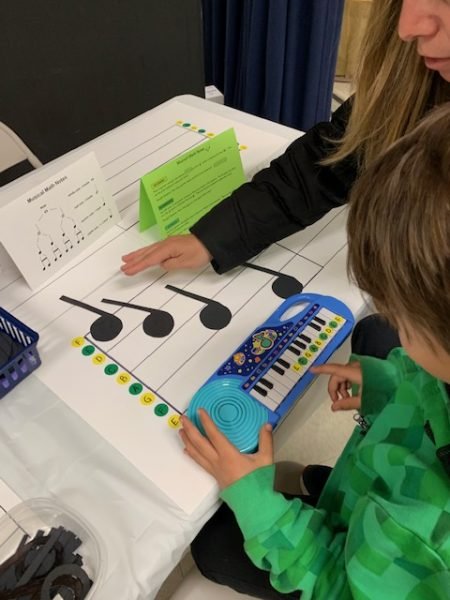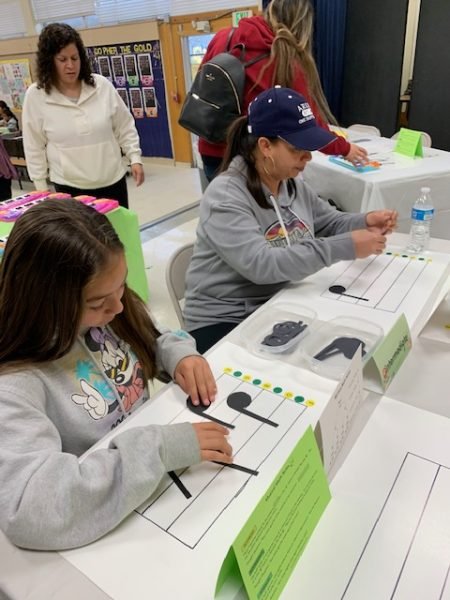
Musical Math Notes: A Family Math Night Activity
I’m always looking for ways to show students (and parents!) that math is everywhere. That was one of my goals when I created a fun station for a recent Family Math Night event: Musical Math Notes.

The Station
My idea was to have students “compose” their own music by placing notes on a staff* and then playing their music on real keyboards. It was a huge hit at our event, and, as is always the case when you do anything new, I learned a lot of things along the way and I’ll share those with you below. But I’m going to start with all the background and set up information.
*A staff is made up of the five horizontal lines and the spaces in between where notes can be placed. Each note on a line or space represents a pitch.


The “Lesson”
I knew going into this that not many students would have been exposed to musical notes…let alone reading musical notes. So I created a table tent that listed the notes and their respective value.
I kept it simple so there would only be 4 beats per measure and used only quarter notes for the Beginning level, quarter and half notes for the Intermediate level, and quarter, half, and eighth notes for the Advanced level. The table tent to the left walked participants through the activity.


Prep Work
In advance of the event I needed to prepare enough staffs for 4 students at each level (Beginning K/1, Intermediate 2/3, Advanced 4/5). For the Advanced level I taped together two staffs. I used white poster board for the staffs and drew the lines two inches apart. That meant that my notes needed to be two inches in diameter.
I created a template* for each of the notes which I cut out of black poster board. To make sure there were enough notes available for 4 students at each level, I needed 44 quarter notes, 20 half notes, and 80 eighth notes. I cut out extra of the quarter and half notes and figured I would probably really only need about 50 eighth notes.
*Note: Another option is to print on cardstock and cut out.


Keyboards
Because it was important – and much more fun – for students to actually hear the music they composed, I needed to find small, cheap keyboards. After a little research I found the ones to the left at Family Dollar for $5 each.
Now I needed to figure out how to get students to know which keys to play once they had composed their music. So I used sticky dots on both the staffs and the keyboards and color-coded them to make them easier to “read”. I also wrote the letter associated with each pitch. The photo to the left shows the final result: the staff, the keyboard, and the notes.


The Set Up
As we do at all our Family Math Night events, I divided this station into three levels: Beginning K/1, Intermediate 2/3, and Advanced 4+. This is reflected in the photo to the left. I chose to set this activity up on the stage because I wanted to minimize the noise from the rest of the event.
This next photo is a close up of the Intermediate table. For each level, I had enough staffs for four students to work at the same time. I also included containers for the notes. Once students had placed their notes on their staff, the Station Facilitator would then hand them a keyboard so they could play their music.
I’ll take you through what I learned below but first here are some fun photos that show how engaged students became. Even the parents wanted in on the fun!




What I Learned
As I mentioned at the beginning, I learned a lot putting this station together and then watching it unfold during the event. Here are some of those lessons learned along with some tips for the next time I do this activity.

I originally set up the keyboards behind the station tables but they were difficult to see so students weren’t drawn to the station. So I moved the table with the keyboards in front of the station tables and as participants walked by, the brightly colored keyboards caught their eye and they wanted in.
Even though the keys and notes were color-coded so that the octave higher note was a different color, some students disregarded this and just looked at the letter. In other words, there were two F notes – one an octave higher and a different color than the other lower F note. But students just looked for F and played the first one they saw. Maybe having the first note on the keyboard be a completely different color and match with the corresponding note on the staff could have helped tie the notes on the staff with the notes on the keyboard.
Another interesting thing that students with no experience reading music did was to place notes on the staff vertical – one on top of the other – instead of horizontal along the staff. Or they placed them on backwards or upside down. The photos below reflect some of their work.



I learned to let go of both of these issues during the event but they each could have been more easily managed with additional Station Facilitators. Which leads me to my first tip:
TIP #1: I would have at least one Station Facilitator per level available to help with directions, etc. At this event I had only one of my staff running the station and…well let’s just say that she slept well that night.
TIP #2: It may have been nice to have a poster showing one measure with appropriately placed notes as a sample of how to place the notes in the measure. This could make it easier for the Station Facilitator to simply point to the poster if needed.
TIP #3: Another thing to consider is that a Family Math Night event can get filled with fabulous math chatter. Because of that, it can get a little noisy. So choosing a location for the activity that is farther removed from the chatter, makes it a little easier to hear the keyboards.
TIP #4: Buy a few extra keyboards. Two of the ones I ordered did not work but I had placed my original order far enough in advance to place a second order.
All in all this was a fabulous activity. I would absolutely do it again at another event. But you don’t need to wait until you have your event to try this out. It would make a great classroom activity, as well. And if you have a buddy class, then it would be fun for the older students to work one-on-one with the younger ones.
Of course, this is just one fun activity at a Family Math Night event. If you plan on hosting an in-person and/or virtual Family Math Night event and have any questions about how we can help, our website has a lot of helpful information but don’t hesitate to reach out, as well.